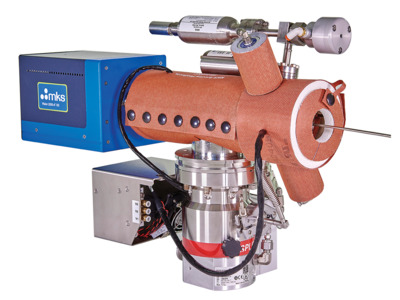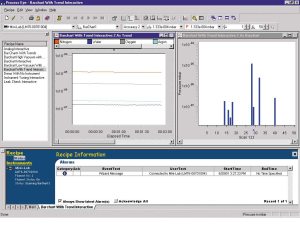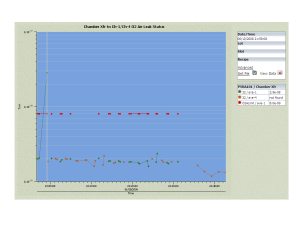Vision 2000-A XD High Sensitivity RGA for ALD & CVD
Overview
The Vision 2000-A XD Residual Gas Analyzer (RGA) improves process productivity and product quality by providing real-time trace level monitoring of various gas species, including precursors, reaction byproducts, and contaminants during ALD and CVD processes. The Vision 2000-A XD system incorporates MKS’ patented V-lens™ technology, taking the proven performance of the Vision 2000-A XD system to a higher level of sensitivity and reliability, previously unachievable with conventional quadrupole mass spectrometry systems (QMS). The V-lens design provides increased sensitivity and reproducibility for the most challenging applications, such as tracking levels of various gas species or reaction byproducts during ALD and CVD deposition processes. With V-lens technology, process engineers can identify and prevent potentially costly issues faster and easier while maximizing yield.
- Modular UniBloc inlet with all metal seals and field-serviceable parts
- V-lens ion optics technology
- Temperature inlet, up to 200°C (consult the factory for models up to 300°C)
Products
| Compare | Description | Drawings, CAD & Specs | Availability | Price | |||
|---|---|---|---|---|---|---|---|

|
VISION-2000-A-XD ALD, CVD Process High Sensitivity RGA |
15 Weeks
|
|
Specifications
-
Mass Range1-100, 1-200, or 1-300 amu
-
Ion SourceHigh conductance closed ion source
-
FilamentsIndependently replaceable twin Tungsten or Thoria filaments
-
Mass FilterDouble filter (1 inch "RF only" pre-filter with 4 inch main filter)
-
DetectorDual (Faraday and secondary electron multiplier)
-
Maximum Analyzer Operating Pressure1e-3 Torr at the ion source inlet (standard), higher pressure optional
-
Minimum Detectable Partial Pressure<1e-12 Torr (for total pressures <1e-4 Torr on baseline inlet
-
Minimum Detectable Concentration<15 ppb (specified with Argon or Nitrogen for non-interfering peaks)
-
Mass StabilityBetter than ±0.1 amu over 8 hours
-
ResolutionBetter than 10% valley between peaks of equal height throughout the mass range
-
Base Pressure RangeMaximum inlet pressure can be chosen in the range of 10 mTorr to 10 torr
-
Process Pressure RangeMaximum inlet pressure can be chosen in the range of 100 mTorr to 760 torr. Please consult the factory for the exact range value closest to your desired pressure. *Inlets for <10 Torr can have optional gas flow acceleration.
-
Mounting FlangeDN35CF (70mm/2.75'' OD) Conflat® flange. Custom adapters can be provided
-
Vacuum Hardware67 l/s turbomolecular pump with high conductance analyzer housing, inlet system, modular UniBloc inlet, automated vacuum control (RVC), completely interlocked and integrated
-
Backing Vacuum SystemStandard: Connected to the tool foreline pump via Surge Protect assembly with a KF16 fitting
Optional: Independent chemically resistant, dry diaphragm pump with KF16 fitting for connecting the exhaust to a suitable scrubber system -
Analyzer Housing Base PressureBetter than 5e-9 Torr after bakeout
-
UniBloc Maximum TemperatureUp to 150°C or up to 200°C
-
Bakeout Temperature and Bakeout JacketIncluded for 180°C bakeout of analyzer chamber
-
Operating Temperature70°C (controlled to ±1°C)
-
Weight33 lbs. (15 kg) to bolt on Process System
-
Mechanical SupportOptional stands and brackets are available
-
Mobile RGA PlatformOptional RGA trolley to improve versatility (footprint 18x24 in., 455x604 mm)
-
Pneumatics60-80 psig CDA
-
Electronics Weight on Flange1.7 kg
-
Power Requirements88-264 VAC, 47/63 Hz, 600 Watts
-
Maximum Operating ConditionsElectronics: 10-40°C, 80% RH (non-condensing)
-
LED Status IndicationInterlock status, filament emission, SEM, power and communications
-
I/O Capability4 analog inputs and 2 outputs (plus 1 dedicated gauge input). Optional support for a large number of both analog and digital inputs and outputs, including relay control
-
Other FacilitiesLeak check headset socket, external filament trip socket, instrument reset
-
SoftwareProcess Eye Professional fully network compatible control platform generating under 32bit or 64bit Microsoft® Windows® 7, Server 2016 or Windows 10 (recommended)
-
CommunicationEthernet CAT-5e
-
PC RequirementsIntel® i5 3.1Ghz or AMD Ryzen 5 4.4Ghz, 8GB RAM, 512 GB hard drive, dependent upon total number of sensors on the computer and the operating system in use. Multi-sensor installation may require higher specifications.
-
Simultaneous Multi-SensorProcess Eye Professional client/server configuration offers flexible multi-sensor operation.
-
RGA to Vacuum System Cable Length33 ft. (10 m) standard RGA and 10 ft. (3m) with mobile RGA platform. Other lengths available dependent upon process system and customer requirements
-
Shipping Weight132 lbs (60 Kg) may vary depending upon backing pump and instrument rack requirements
-
ComplianceCE, UKCA
Features
"Smart Head" RGA Technolgy
The Vision 2000-A XD incorporates the Microvision 2 "smart head" RGA technology with a closed ion source and close-coupled inlet. This state of-the-art RGA technology is integrated with the Process Eye Professional control platform, a recipe based, user configurable software program. The combination of a closed ion source and automated inlet allows seamless monitoring of the complete ALD or CVD process cycle, from base vacuum to process pressures up to 760 Torr. By maximizing the ratio between ALD and CVD chamber gas signals and the gas background in the differentially pumped Vision 2000-A XD analyzer housing, the closed ion source enables approximately 15ppb-level detection for trace reaction byproducts and contaminants in the process gas. The closed ion source analyzer is manufactured from vacuum prepared stainless steel and highdensity alumina ceramics and features independently replaceable twin filaments to provide built-in backup in the event of a filament failure. The standard system includes a double filter analyzer to increase the sensitivity of high mass species (for ALD/CVD precursors with high molecular weight), improving contamination resistance and enhancing long-term stability.
Each Vision 2000-A XD system incorporates a Remote Vacuum Controller (RVC) that provides fail-safe protection for both the process tool and the RGA. It allows full operation and control of RGA system components (filaments, pumps, inlet valves, bakeout, etc.) from the system PC. Available in a compact, remotelymounted rack module the RVC and power supplies. The unit is easily mounted onto any standard 19” tool rack for mounting on a process chamber or other compatible location. Thirty-threefoot (10 m) cables are included as standard so that the probe assembly can be located in a remote position (other lengths are available).
High Temperature Modular UniBloc™ Inlet
The Vision 2000-A XD modular UniBloc is designed to operate at temperatures of up to 200°C for the whole sampling inlet with modular valves and flow elements. All external seals are metal. Many ALD and CVD precursors are liquid or solid at room temperature and may condense, leading to blockage of the gas sampling inlet if the sampling inlet and valve are not at the required temperature. A conformal heating jacket provides uniform temperature control of the whole inlet and valve, eliminating cold spots and preventing precursor condensation, minimizing deposition within the valve and maintaining mobility of sticky or polar gases through the inlet. The high temperature sampling inlet of the Vision 2000-A XD resists blockage and enhances the lifetime of the inlet during sampling of ALD or CVD precursors. If flow element or valve maintenance is required, the new modular design makes it a quick and cost-effective end-user operation, easily performed in the field.
The modular UniBloc was engineered to have minimal internal volume and surface area, reducing surface reactions, and providing fast response to ALD process chemistries. Furthermore, a sample transfer tube can be connected directly onto the face of the modular UniBloc, giving a fast, coaxial flow path from the optimum point of the process equipment to the ion source. From its 1/8" internal compression ferrule connection, users can readily adapt to any choice of tube size and material. The exclusive fast response of the new modular UniBloc inlet manifold allows sampling at both background and process pressures through specific, selected orifices. When not sampling, the inlet valves close and the analyzer is automatically isolated from the process chamber. Optional purging of the inlet is available, flowing inert gas through the mass spectrometer system while not sampling (purge gas does not flow to the process chamber). Such purging is active during bakeout, reducing initial startup time and residual background recovery time.
When sampling gases from >10 Torr, two-stage pressure reduction is provided using bypass pumping. For processes with maximum pressures <10 Torr, low-flow sampling through a single orifice is common, but with performance degradation in ALD applications. With the modular UniBloc inlet, a special configuration is available to draw supplemental sample flow to the inlet via bypass pumping, reducing both sample gas transfer lag and spreading of gas composition changes. In combination with a direct sample transfer tube, this optimizes pulse monitoring.
The inlet valve is operated by integrated electronics and controlled via recipes from Process Eye Professional. The required valve selection is made automatically by a gas independent pressure sensor in the modular UniBloc inlet which also provides a readout of the process chamber total pressure in the Process Eye Professional software.
V-lens™ Technology
ALD and CVD processes typically employ inert gases such as Argon or Nitrogen for precursor carrier gas or purge gas between ALD pulsed cycles. The use of these gases can be challenging as they generate an elevated baseline in RGAs due to large amounts of chemical background noise caused by metastable decay. This results in reduced sensitivity which can be problematic for manufacturers who want to identify changes in trace gases (which are indicative of issues during the manufacturing process) quickly and easily. V-lens technology, a unique enabling solution, helps overcome this issue by providing a consistently low mass independent baseline and detection levels in the low ppb range. This is achieved with unique ion optics that utilize a patented double-focusing and deflection mechanism that significantly reduces background and enhances sensitivity. The result is a gas analyzer with limits of detection in the low ppb range without compromising any other aspect of performance.
This state-of-the-art RGA technology is integrated with Process Eye Professional control platform, a recipe based, user-configurable software program. The combination of V-lens, a closed ion source, and automated inlet allows for sensitive and reproducible monitoring of the complete ALD or CVD process cycle. By maximizing the ratio between ALD and CVD chamber gas signals and the gas background in the differentially pumped analyzer housing, the V-lens and closed ion source enables ppb-level detection for trace contaminants in the process gas.
Process Eye™ Professional Control Platform
The Vision 2000-A XD analyzer uses Process Eye Professional, a highly flexible, modular application operating under 32bit or 64bit Windows 7, Server 2016 or Windows 10. Designed with a "client/server" structure, Process Eye Professional incorporates TCP/IP protocol for full network compatibility. Creating UniBloc inlet valve process recipes is made easy by the recipe wizard function, which allows customized warnings and alarm levels to be triggered whenever the process exceeds preset levels. The Process Eye Professional recipes also specify the way in which the Vision 2000-A XD acquires, displays, and stores data. Other key parameters, such as ion source settings, can be set via the Process Eye Professional recipe. This allows the user to optimize settings for each phase of the process independently. For example, ideal settings for baseline can be set up in the baseline recipe, ideal settings for process monitoring can be set in the process recipe, etc.
Process Eye Professional enhances the Vision 2000-A XD by providing:
- Automated and intelligent operation of MKS RGAs with fully customizable controls and alarms
- Recipes for automated calibration
- Flexible scanning
Bar Chart, Analog and Peak Jump scanning modes which can be mixed and associated with data trend displays - Intelligent, user defined warnings and alarms
Can include a suggested diagnosis of the fault condition and recommended solution - Data displays in relevant units, such as Torr, mbar or Pa in the process chamber
- Optional ability to read data from other sensors using analog inputs and external events by digital inputs
- Data buffer for quick on-line review of recent data
- Full storage of all data for subsequent review and analysis
TOOLweb® RGA
Using the same RGA integration option for process tools, Vision 2000-A XD can be used for all ALD, and CVD process in a completely automated process environment. TOOLweb RGA maintains a constant monitoring of tool activities with all sensor data being framed by wafer logistics before alarm models are applied. Full alarm and data reporting to the FAB host and FDC are available allowing real-time monitoring of chamber conditions and flagging of any process excursions from ideal conditions.
Resources
Literature
- Vision 2000-A XD High Sensitivity RGA for ALD & CVD (2.7 MB, PDF)
Drawings & CADs
- Vision 2000-A & Vision 2000-A XD Dimensional Drawing (499.1 kB, PDF)
- Vision 2000-A XD DXF File (648.9 kB, ZIP)




 Ultra-High Velocity
Ultra-High Velocity